3 February 2023
Weekly Market View
Nearing the end
This week, three of the world’s most powerful central banks raised rates to new 14-year highs and signalled they are likely to hike at least once more and remain restrictive for a while. However, markets chose to look at the bright side – that the sharpest series of rate hikes in more than four decades is nearing its end.
We are more sceptical about the outlook for risk assets. We now expect the Fed and ECB to raise policy rates to 5% and 3.0-3.25% respectively in H1 and maintain them near the peak for the rest of the year. This is likely to impact equity valuations and corporate earnings.
This macro backdrop, combined with stretched investor positioning, argues for fading the rally in US and Euro area equities and looking for opportunities to rebalance to bonds and stocks in Asia ex-Japan, where the outlook is brightening.
We also see further USD downside and broadly stable US bond yields near term, which should support flows to Asia.
Is further consolidation likely in the Hang Seng index?
What is the outlook for US government bond yields after the latest Fed meeting?
Are you still expecting a near-term bounce in the USD?
Charts of the week: Breaking higher?
S&P500 index broke above a key technical resistance, even as the Fed tightened its policy rate above inflation
S&P500 index, with next key technical resistance levels
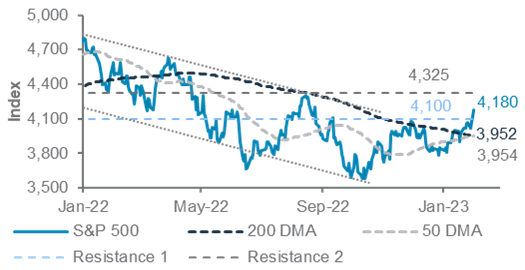
Fed rate, US core inflation (personal consumption expenditure)
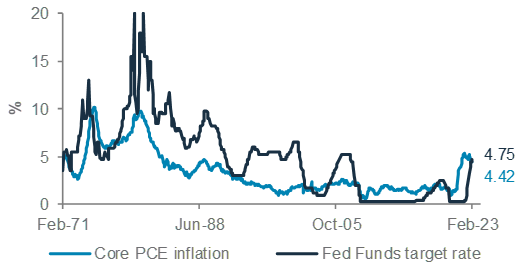
Source: Bloomberg, Standard Chartered
Editorial
Time to fade the rally in Europe
This week, three of the world’s most powerful central banks raised rates to new 14-year highs and signalled they are likely to hike at least once more and remain restrictive for a while. However, markets chose to look at the bright side – that the sharpest series of rate hikes in more than four decades is nearing its end. US stocks broke above key resistance and European stocks rose to a nine-month high, having recovered more than four-fifths of the losses since the end of 2021.
We are more sceptical about the outlook for risk assets, though; we now expect the Fed and ECB to raise policy rates to 5% and 3.0-3.25% respectively in H1 and maintain them near the peak for the rest of the year even as economic data deteriorates. Restrictive rates and wage gains are likely to impact equity valuations and erode corporate margins, leading to earnings estimate downgrades. This outlook confirms our SAFE asset allocation stance at the start of the year: staying overweight on higher grade bonds and other income assets at the expense of equities. Add to that crowded investor positioning (see page 10), and we would continue to fade the rally in US and Euro area equities and look for opportunities to rebalance to bonds and stocks in Asia ex-Japan, where the outlook is brightening.
Of course, our latest review of the macro environment indicated several improvements since late 2022:
a) Headline inflation has peaked in major economies, enabling central banks to slow the pace of (and in some cases end) rate hikes; b) China and the Euro area economies are recovering, aided by policy stimulus and a plunge in gas prices (the IMF this week bumped up 2023 growth forecasts sharply); c) A weaker USD is easing global financial conditions and risk sentiment; d) Institutional investor positioning remains bearish on equities (although less so since Q3 last year); e) As a result of the above factors, risk assets are pricing in a goldilocks scenario of a shallow downturn in the US and Euro area, without severe dislocation to job markets and consumption as inflation gradually settles back towards central bank targets.
Nevertheless, we believe the scenario that markets are pricing in, extrapolating the above improvements, is too optimistic:
a) Global growth is set to slow this year as policy rates become restrictive, even as the dire outcome in Europe has faded; b) the US economy is slowing decisively (this week’s contractionary ISM Manufacturing and New Orders PMIs attest to that); c) Yet labour markets in the US and Europe remain tight (as seen in bigger-than-expected rise in US job openings, drop in initial jobless claims to near-record lows and Euro area jobless rate staying close to near-record lows); d) Core inflation, especially in services sector ex-housing, remains high in the US and continues to rise in Europe; e) China’s recovery is likely to add almost 0.5-1 percentage points to global inflation, challenging the disinflation narrative in the coming quarters; f) Corporate earnings are likely to slow as margins tighten, while earnings estimates have yet to be downgraded significantly; g) Expectations of an economic soft-landing and central bank policy pivots are contradictory – central banks are unlikely to cut rates if the economy and job markets don’t deteriorate sharply. Central banks are also unlikely to tolerate a significant easing of financial conditions (through higher stock markets and narrower HY spreads) before the inflation battle has been won; and h) several risk assets are showing one-sided investor positioning, raising the risk of a near-term reversal. These include Europe and Asia ex-Japan stocks, the EUR and gold.
Investment implications: On balance, we believe many risk assets have likely run ahead of fundamentals. While strong momentum points to near-term upside for US and Europe equities, we would look for opportunities to switch to Asian ex-Japan equities (see page 5). We also see further downside for the USD and broadly stable US bond yields in the near term (see page 4), which should support flows to Asia.
— Rajat Bhattacharya
The weekly macro balance sheet
Our weekly net assessment: On balance, we see the past week’s data and policy as neutral for risk assets in the near term.
(+) factor: Easing US inflation, resilient Euro area economy
(-) factor: Falling US PMIs, hiking central banks, geopolitical tensions
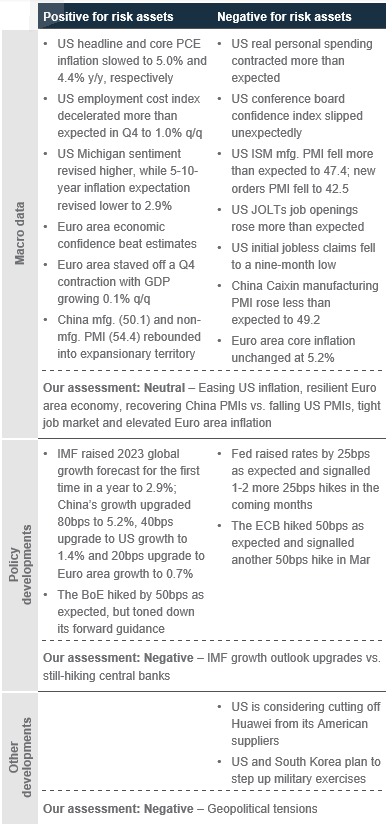
US manufacturing activity continued to deteriorate, but the job market remained robust
US ISM Manufacturing and new orders PMI, US job openings (JOLTS)
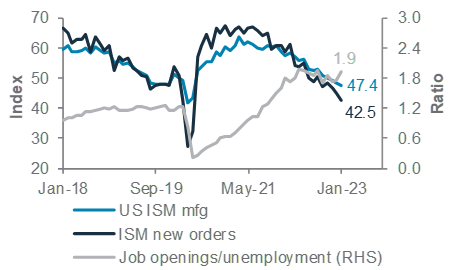
Euro area headline inflation continued to decline with falling energy prices, but core inflation remained elevated
Euro area headline and core inflation
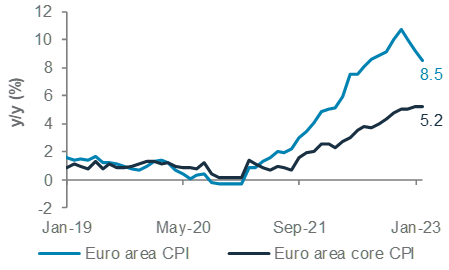
China’s economic activity rebounded strongly in January as mobility restrictions were removed
China manufacturing and non-manufacturing PMIs
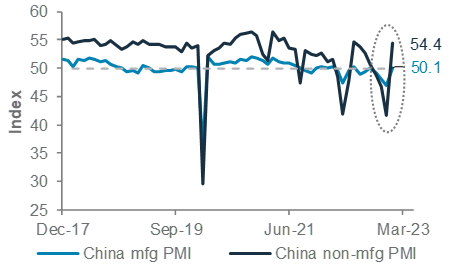
Top client questions
Are you still expecting a near-term bounce in the USD?
We have revised our near-term (three-month) outlook for the USD modestly lower and other major currencies higher following the Fed, ECB and BoE meetings earlier this week.
Fed Chair Powell appeared to be less hawkish relative to our expectations after slowing down the pace of rate hikes. Since multiple economic data indicators continue to point towards a slowdown in growth and inflation, we believe the Fed is likely to be under pressure to cut rates late in 2023, which means that markets are likely to push the USD lower in anticipation of rate cuts. Hence, we look for a modest downside in the USD in the next 3 months.
Our upward revision in ECB rate hike projections, along with an improvement in the energy security situation in Europe and positive growth surprise in Q4 growth, lead us to revise our near-term EUR/USD forecast higher to 1.12. A narrowing of real interest rate differentials with the US and positive investor sentiment are likely to be supportive for the common currency.
We also expect near-term strength in the AUD, NZD and CAD as the commodity currencies are likely to benefit from the faster-than-expected re-opening in China. As we head closer to the end of BoJ Governor Kuroda’s term in April, market expectations of a shift in monetary policy are likely to push USD/JPY lower.
— Abhilash Narayan, Senior Investment Strategist
We revise our 3-month forecasts for the USD and other major currency pairs
Revised 3-month forecasts
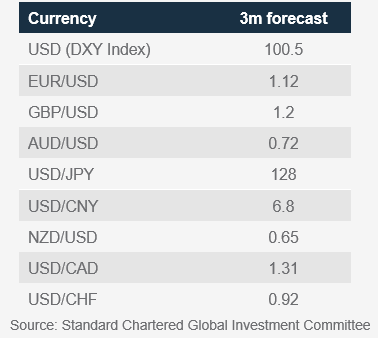
Our assessment of the current global macro backdrop and its impact on risk assets
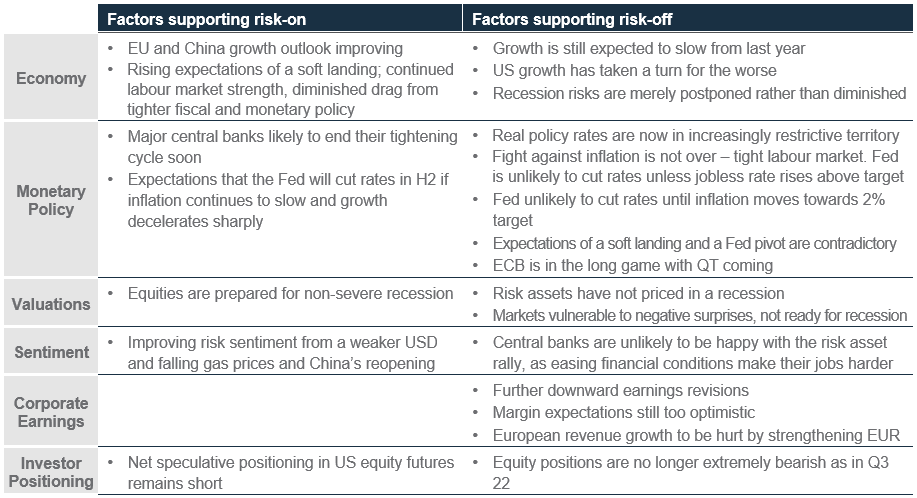
— Zhong Liang Han, Investment Strategist
Top client questions (cont’d)
Is further consolidation likely in the Hang Seng Index?
We believe the medium-term case for rising Chinese equities remains intact. This is because we believe the four factors that drove the downtrend in the Hang Seng Index since Q1 2021 – properties, internet regulations, threat of ADR delisting in the US, and mobility restrictions – are likely to continue to subside.
However, a pullback is likely in the short term (1-3 months). Chinese equities have become a consensus overweight. While the index has been climbing for most of January, volume has not been increasing, suggesting a lack of sustaining power in the rally. Moreover, there is risk from short-term fund rotation back into US equities. Nearly half the companies in the S&P500 index have reported earnings thus far, with 70% beating consensus estimates, giving a positive earnings surprise of 2.2%. The S&P500 index has just broken above a key resistance level at 4,100, propelled by a dovish FOMC meeting.
Hence, technicals argue the S&P500 index may have more room to run, possibly reaching key resistance levels at 4,325 and 4,512. We believe it will become more attractive to consider rotating back into the Hang Seng Index once the S&P500 index approaches these resistance levels, especially if the Hang Seng Index reaches key support levels at 20,300 and 19,300.
— Daniel Lam, Head, Equity Strategy
The Hang Seng index could see a pullback towards the “support zone” around 19,300 to 20,300
Hang Seng index
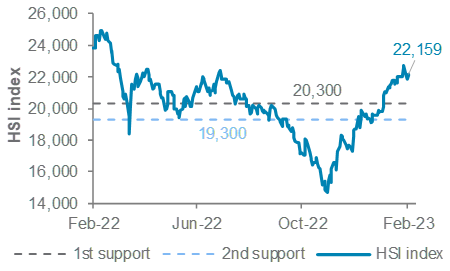
What is the outlook for US government bond yields after the latest Fed meetings?
The February Fed policy meeting concluded with Fed Fund Rate being raised by 25bps and the statement reiterating the need to hike rates further as inflation remains above long-term target. However, the market focused on the dovish takeaways in the post-meeting conference, resulting in US government bond yields falling. At his speech, Fed Chair Powell said he recognized disinflation has started and appeared to be relatively unconcerned about the discrepancy between market expectation and the Fed dot plots.
We revise our 3-month 10Y US government bond yield target lower to 3.25% – 3.5%. In our view, markets are likely to continue to look through forthcoming Fed rate hikes if Chair Powell continues to refrain from fighting the market. Macroeconomic data continues to deliver a mixed picture. Although the US labour market showed signs of lingering tightness, leading indicators are pointing towards higher downside risk to the economy. In addition, bond technicals favour largely anchored yields, which we believe will remain in place through to the last Fed rate hike of this cycle.
The 10-year yield is currently testing key support level of c.3.3%. Nonetheless, the building up of net short future positions since the start of the year should help yields from breaking substantially lower. Hence, we see high likelihood that the 10-year yield trades in range going forward, as we retain our year-end target at 3.25%.
— Cedric Lam, Senior Investment Strategist
Net short positions in US 10-year government bonds have surged since the start of the year
US 10-year government bond yield and net futures positions
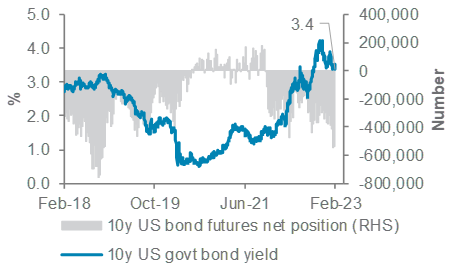
Top client questions (cont’d)
What is the implication of India’s budget on markets?
India’s budget surprised markets by taking significant steps to spur growth while maintaining fiscal prudence. Announced measures to boost growth include: 1) Higher capital expenditure: FY 2024 capital expenditure is forecast to increase by 33% to a record USD 123bn (c.3.3% of GDP), with a focus on key infrastructure sectors such as railways and roads; 2) Boost to manufacturing, with the doubling of allocation for manufacturing subsidies. This follows other long-term reforms (such as corporate tax cuts, import duty changes and the production-linked incentive scheme) initiated in recent years as part of the push to develop India as a global manufacturing hub; and 3) A cut in personal income taxes could boost middle class disposable income and spur domestic spending, aiding economic recovery. These measures were balanced by the government sticking to its fiscal consolidation path, with FY 2024 budget deficit set at 5.9% of GDP vs 6.4% of GDP for FY 2023. More importantly, the shift in the quality of spending towards capex and cuts in subsidies towards pre-pandemic levels are likely to support India’s macro fundamentals.
A pro-growth budget that also maintains fiscal prudence is likely to keep inflationary expectations muted. India’s growth-inflation dynamics remain superior to that of its peers, which could better support its assets against external shocks. Indian equities have struggled this year to replicate their spectacular outperformance vs Asia ex-Japan in 2021 and 2022 given elevated valuations. We expect Indian equities to perform in line with Asia-ex Japan equities.
However, in our assessment, still-robust earnings growth, possible return of foreign investment flows and resilient domestic inflows through stable systematic investment plans are key supports for equities. Within Indian equities, we are Overweight large-cap equities. The budget is likely to support structural equity themes that have a longer runway for growth. We continue to see attractive value in financials, domestic cyclicals, and investment-led themes mainly focused on the manufacturing and infrastructure sectors.
Bond yields are likely to trend lower, with the budget unlikely to be inflationary given the improving quality of spending. Furthermore, with inflation trending lower over the last few months, interest rates are expected to peak out with consensus expecting the RBI to deliver its final rate hike in the current cycle at its February review next week. We continue to see increasing value in bonds, especially relative to equities. The budget is mildly positive for the INR as continued fiscal consolidation, strong focus on capex outlay and lower market borrowings are supportive for Indian assets. However, near-term risks remain on the downside for the INR given still-wide trade deficit, foreign portfolio outflows from equity markets, and likely RBI intervention as it tries to rebuild its FX reserves.
— Vinay Joseph, Head of Investment Products and Strategy, India
India’s government stuck to fiscal consolidation path; significant increase in capital expenditure
Key numbers from the Indian federal budget
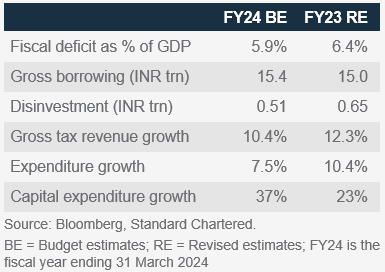
Trends in India’s equity sector earnings estimates
Sector EPS trends since the start for FY23
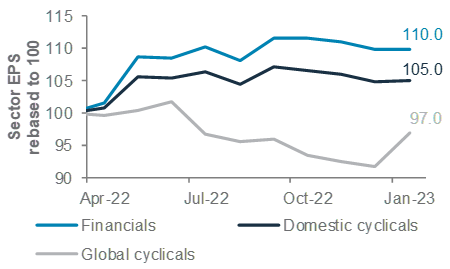
Market performance summary*
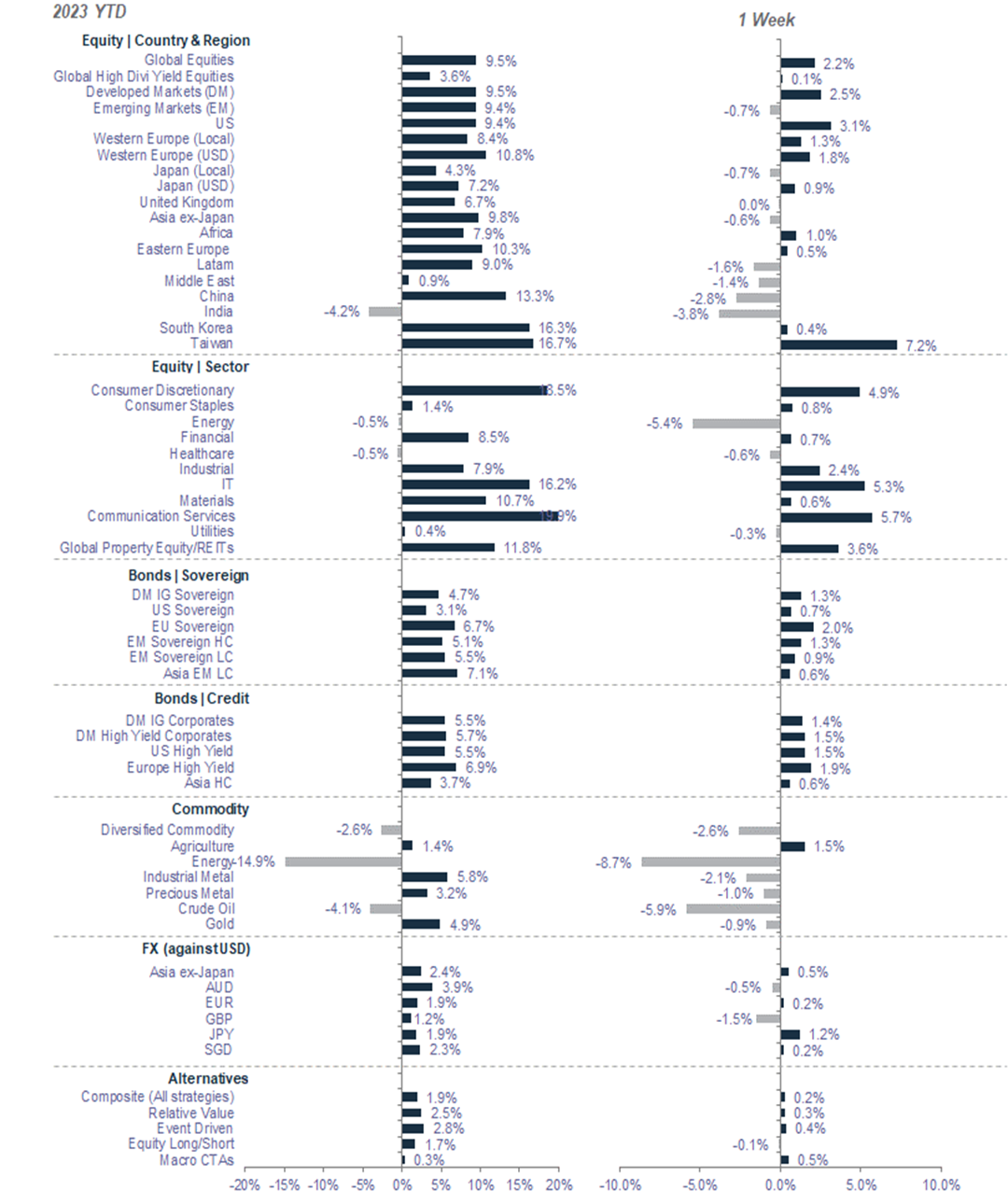
*Performance in USD terms unless otherwise stated, 2023 YTD performance from 31 December 2022 to 2 February 2023; 1-week period: 26 January 2023 to 2 February 2023
Our 12-month asset class views at a glance
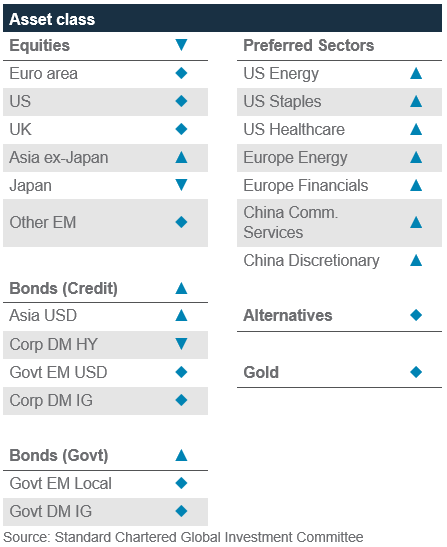
Economic and market calendar
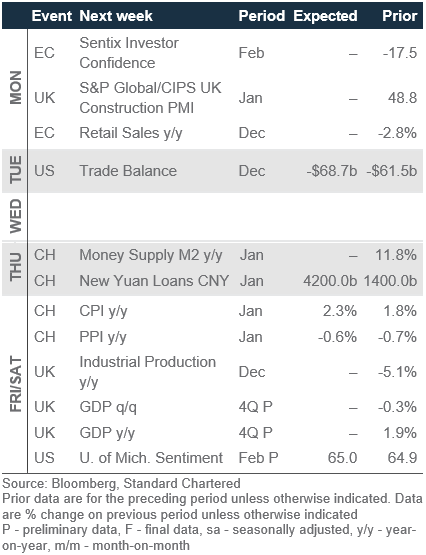
The S&P500 index faces next resistance at 4,234
Technical indicators for key markets as of 2 February close
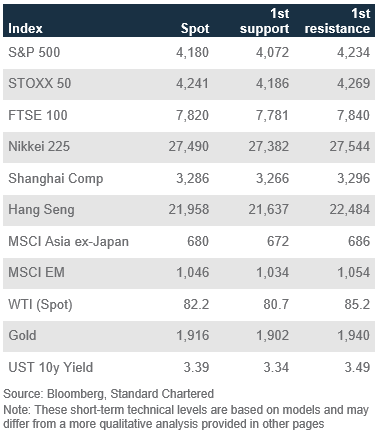
Investor diversity has deteriorated in Europe stocks
Our proprietary market diversity indicators as of 2 February
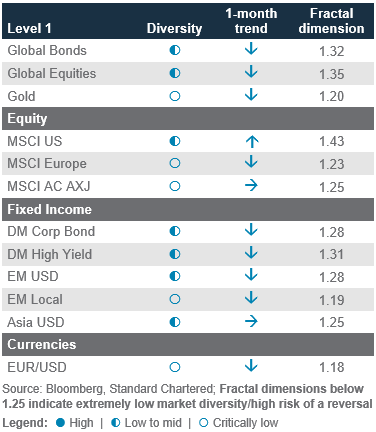
Disclosure
This document is confidential and may also be privileged. If you are not the intended recipient, please destroy all copies and notify the sender immediately. This document is being distributed for general information only and is subject to the relevant disclaimers available at our Standard Chartered website under Regulatory disclosures. It is not and does not constitute research material, independent research, an offer, recommendation or solicitation to enter into any transaction or adopt any hedging, trading or investment strategy, in relation to any securities or other financial instruments. This document is for general evaluation only. It does not take into account the specific investment objectives, financial situation or particular needs of any particular person or class of persons and it has not been prepared for any particular person or class of persons. You should not rely on any contents of this document in making any investment decisions. Before making any investment, you should carefully read the relevant offering documents and seek independent legal, tax and regulatory advice. In particular, we recommend you to seek advice regarding the suitability of the investment product, taking into account your specific investment objectives, financial situation or particular needs, before you make a commitment to purchase the investment product. Opinions, projections and estimates are solely those of SC at the date of this document and subject to change without notice. Past performance is not indicative of future results and no representation or warranty is made regarding future performance. The value of investments, and the income from them, can go down as well as up, and you may not recover the amount of your original investment. You are not certain to make a profit and may lose money. Any forecast contained herein as to likely future movements in rates or prices or likely future events or occurrences constitutes an opinion only and is not indicative of actual future movements in rates or prices or actual future events or occurrences (as the case may be). This document must not be forwarded or otherwise made available to any other person without the express written consent of the Standard Chartered Group (as defined below). Standard Chartered Bank is incorporated in England with limited liability by Royal Charter 1853 Reference Number ZC18. The Principal Office of the Company is situated in England at 1 Basinghall Avenue, London, EC2V 5DD. Standard Chartered Bank is authorised by the Prudential Regulation Authority and regulated by the Financial Conduct Authority and Prudential Regulation Authority. Standard Chartered PLC, the ultimate parent company of Standard Chartered Bank, together with its subsidiaries and affiliates (including each branch or representative office), form the Standard Chartered Group. Standard Chartered Private Bank is the private banking division of Standard Chartered. Private banking activities may be carried out internationally by different legal entities and affiliates within the Standard Chartered Group (each an “SC Group Entity”) according to local regulatory requirements. Not all products and services are provided by all branches, subsidiaries and affiliates within the Standard Chartered Group. Some of the SC Group Entities only act as representatives of Standard Chartered Private Bank and may not be able to offer products and services or offer advice to clients.
Copyright © 2025, Accounting Research & Analytics, LLC d/b/a CFRA (and its affiliates, as applicable). Reproduction of content provided by CFRA in any form is prohibited except with the prior written permission of CFRA. CFRA content is not investment advice and a reference to or observation concerning a security or investment provided in the CFRA SERVICES is not a recommendation to buy, sell or hold such investment or security or make any other investment decisions. The CFRA content contains opinions of CFRA based upon publicly-available information that CFRA believes to be reliable and the opinions are subject to change without notice. This analysis has not been submitted to, nor received approval from, the United States Securities and Exchange Commission or any other regulatory body. While CFRA exercised due care in compiling this analysis, CFRA, ITS THIRD-PARTY SUPPLIERS, AND ALL RELATED ENTITIES SPECIFICALLY DISCLAIM ALL WARRANTIES, EXPRESS OR IMPLIED, INCLUDING, BUT NOT LIMITED TO, ANY WARRANTIES OF MERCHANTABILITY OR FITNESS FOR A PARTICULAR PURPOSE OR USE, to the full extent permitted by law, regarding the accuracy, completeness, or usefulness of this information and assumes no liability with respect to the consequences of relying on this information for investment or other purposes. No content provided by CFRA (including ratings, credit-related analyses and data, valuations, model, software or other application or output therefrom) or any part thereof may be modified, reverse engineered, reproduced or distributed in any form by any means, or stored in a database or retrieval system, without the prior written permission of CFRA, and such content shall not be used for any unlawful or unauthorized purposes. CFRA and any third-party providers, as well as their directors, officers, shareholders, employees or agents do not guarantee the accuracy, completeness, timeliness or availability of such content. In no event shall CFRA, its affiliates, or their third-party suppliers be liable for any direct, indirect, special, or consequential damages, costs, expenses, legal fees, or losses (including lost income or lost profit and opportunity costs) in connection with a subscriber’s, subscriber’s customer’s, or other’s use of CFRA’s content.
Market Abuse Regulation (MAR) Disclaimer
Banking activities may be carried out internationally by different branches, subsidiaries and affiliates within the Standard Chartered Group according to local regulatory requirements. Opinions may contain outright “buy”, “sell”, “hold” or other opinions. The time horizon of this opinion is dependent on prevailing market conditions and there is no planned frequency for updates to the opinion. This opinion is not independent of Standard Chartered Group’s trading strategies or positions. Standard Chartered Group and/or its affiliates or its respective officers, directors, employee benefit programmes or employees, including persons involved in the preparation or issuance of this document may at any time, to the extent permitted by applicable law and/or regulation, be long or short any securities or financial instruments referred to in this document or have material interest in any such securities or related investments. Therefore, it is possible, and you should assume, that Standard Chartered Group has a material interest in one or more of the financial instruments mentioned herein. Please refer to our Standard Chartered website under Regulatory disclosures for more detailed disclosures, including past opinions/ recommendations in the last 12 months and conflict of interests, as well as disclaimers. A covering strategist may have a financial interest in the debt or equity securities of this company/issuer. All covering strategist are licensed to provide investment recommendations under Monetary Authority of Singapore or Hong Kong Monetary Authority. This document must not be forwarded or otherwise made available to any other person without the express written consent of Standard Chartered Group.
Sustainable Investments
Any ESG data used or referred to has been provided by Morningstar, Sustainalytics, MSCI or Bloomberg. Refer to 1) Morningstar website under Sustainable Investing, 2) Sustainalytics website under ESG Risk Ratings, 3) MCSI website under ESG Business Involvement Screening Research and 4) Bloomberg green, social & sustainability bonds guide for more information. The ESG data is as at the date of publication based on data provided, is for informational purpose only and is not warranted to be complete, timely, accurate or suitable for a particular purpose, and it may be subject to change. Sustainable Investments (SI): This refers to funds that have been classified as ‘Sustainable Investments’ by Morningstar. SI funds have explicitly stated in their prospectus and regulatory filings that they either incorporate ESG factors into the investment process or have a thematic focus on the environment, gender diversity, low carbon, renewable energy, water or community development. For equity, it refers to shares/stocks issued by companies with Sustainalytics ESG Risk Rating of Low/Negligible. For bonds, it refers to debt instruments issued by issuers with Sustainalytics ESG Risk Rating of Low/Negligible, and/or those being certified green, social, sustainable bonds by Bloomberg. For structured products, it refers to products that are issued by any issuer who has a Sustainable Finance framework that aligns with Standard Chartered’s Green and Sustainable Product Framework, with underlying assets that are part of the Sustainable Investment universe or separately approved by Standard Chartered’s Sustainable Finance Governance Committee. Sustainalytics ESG risk ratings shown are factual and are not an indicator that the product is classified or marketed as “green”, “sustainable” or similar under any particular classification system or framework.
Country/Market Specific Disclosures
Botswana: This document is being distributed in Botswana by, and is attributable to, Standard Chartered Bank Botswana Limited which is a financial institution licensed under the Section 6 of the Banking Act CAP 46.04 and is listed in the Botswana Stock Exchange. Brunei Darussalam: This document is being distributed in Brunei Darussalam by, and is attributable to, Standard Chartered Bank (Brunei Branch) | Registration Number RFC/61 and Standard Chartered Securities (B) Sdn Bhd | Registration Number RC20001003. Standard Chartered Bank is incorporated in England with limited liability by Royal Charter 1853 Reference Number ZC18. Standard Chartered Securities (B) Sdn Bhd is a limited liability company registered with the Registry of Companies with Registration Number RC20001003 and licensed by Brunei Darussalam Central Bank as a Capital Markets Service License Holder with License Number BDCB/R/CMU/S3-CL and it is authorised to conduct Islamic investment business through an Islamic window. China Mainland: This document is being distributed in China by, and is attributable to, Standard Chartered Bank (China) Limited which is mainly regulated by National Financial Regulatory Administration (NFRA), State Administration of Foreign Exchange (SAFE), and People’s Bank of China (PBOC). Hong Kong: In Hong Kong, this document, except for any portion advising on or facilitating any decision on futures contracts trading, is distributed by Standard Chartered Bank (Hong Kong) Limited (“SCBHK”), a subsidiary of Standard Chartered PLC. SCBHK has its registered address at 32/F, Standard Chartered Bank Building, 4-4A Des Voeux Road Central, Hong Kong and is regulated by the Hong Kong Monetary Authority and registered with the Securities and Futures Commission (“SFC”) to carry on Type 1 (dealing in securities), Type 4 (advising on securities), Type 6 (advising on corporate finance) and Type 9 (asset management) regulated activity under the Securities and Futures Ordinance (Cap. 571) (“SFO”) (CE No. AJI614). The contents of this document have not been reviewed by any regulatory authority in Hong Kong and you are advised to exercise caution in relation to any offer set out herein. If you are in doubt about any of the contents of this document, you should obtain independent professional advice. Any product named herein may not be offered or sold in Hong Kong by means of any document at any time other than to “professional investors” as defined in the SFO and any rules made under that ordinance. In addition, this document may not be issued or possessed for the purposes of issue, whether in Hong Kong or elsewhere, and any interests may not be disposed of, to any person unless such person is outside Hong Kong or is a “professional investor” as defined in the SFO and any rules made under that ordinance, or as otherwise may be permitted by that ordinance. In Hong Kong, Standard Chartered Private Bank is the private banking division of SCBHK, a subsidiary of Standard Chartered PLC. Ghana: Standard Chartered Bank Ghana Limited accepts no liability and will not be liable for any loss or damage arising directly or indirectly (including special, incidental or consequential loss or damage) from your use of these documents. Past performance is not indicative of future results and no representation or warranty is made regarding future performance. You should seek advice from a financial adviser on the suitability of an investment for you, taking into account these factors before making a commitment to invest in an investment. To unsubscribe from receiving further updates, please send an email to feedback.ghana@sc.com. Please do not reply to this email. Call our Priority Banking on 0302610750 for any questions or service queries. You are advised not to send any confidential and/or important information to Standard Chartered via e-mail, as Standard Chartered makes no representations or warranties as to the security or accuracy of any information transmitted via e-mail. Standard Chartered shall not be responsible for any loss or damage suffered by you arising from your decision to use e-mail to communicate with the Bank. India: This document is being distributed in India by Standard Chartered in its capacity as a distributor of mutual funds and referrer of any other third party financial products. Standard Chartered does not offer any ‘Investment Advice’ as defined in the Securities and Exchange Board of India (Investment Advisers) Regulations, 2013 or otherwise. Services/products related securities business offered by Standard Charted are not intended for any person, who is a resident of any jurisdiction, the laws of which imposes prohibition on soliciting the securities business in that jurisdiction without going through the registration requirements and/or prohibit the use of any information contained in this document. Indonesia: This document is being distributed in Indonesia by Standard Chartered Bank, Indonesia branch, which is a financial institution licensed and supervised by Otoritas Jasa Keuangan (Financial Service Authority) and Bank Indonesia. Jersey: In Jersey, Standard Chartered Private Bank is the Registered Business Name of the Jersey Branch of Standard Chartered Bank. The Jersey Branch of Standard Chartered Bank is regulated by the Jersey Financial Services Commission. Copies of the latest audited accounts of Standard Chartered Bank are available from its principal place of business in Jersey: PO Box 80, 15 Castle Street, St Helier, Jersey JE4 8PT. Standard Chartered Bank is incorporated in England with limited liability by Royal Charter in 1853 Reference Number ZC 18. The Principal Office of the Company is situated in England at 1 Basinghall Avenue, London, EC2V 5DD. Standard Chartered Bank is authorised by the Prudential Regulation Authority and regulated by the Financial Conduct Authority and Prudential Regulation Authority. The Jersey Branch of Standard Chartered Bank is also an authorised financial services provider under license number 44946 issued by the Financial Sector Conduct Authority of the Republic of South Africa. Jersey is not part of the United Kingdom and all business transacted with Standard Chartered Bank, Jersey Branch and other SC Group Entity outside of the United Kingdom, are not subject to some or any of the investor protection and compensation schemes available under United Kingdom law. Kenya: This document is being distributed in Kenya by and is attributable to Standard Chartered Bank Kenya Limited. Investment Products and Services are distributed by Standard Chartered Investment Services Limited, a wholly owned subsidiary of Standard Chartered Bank Kenya Limited that is licensed by the Capital Markets Authority in Kenya, as a Fund Manager. Standard Chartered Bank Kenya Limited is regulated by the Central Bank of Kenya. Malaysia: This document is being distributed in Malaysia by Standard Chartered Bank Malaysia Berhad (“SCBMB”). Recipients in Malaysia should contact SCBMB in relation to any matters arising from, or in connection with, this document. This document has not been reviewed by the Securities Commission Malaysia. The product lodgement, registration, submission or approval by the Securities Commission of Malaysia does not amount to nor indicate recommendation or endorsement of the product, service or promotional activity. Investment products are not deposits and are not obligations of, not guaranteed by, and not protected by SCBMB or any of the affiliates or subsidiaries, or by Perbadanan Insurans Deposit Malaysia, any government or insurance agency. Investment products are subject to investment risks, including the possible loss of the principal amount invested. SCBMB expressly disclaim any liability and responsibility for any loss arising directly or indirectly (including special, incidental or consequential loss or damage) arising from the financial losses of the Investment Products due to market condition. Nigeria: This document is being distributed in Nigeria by Standard Chartered Bank Nigeria Limited (SCB Nigeria), a bank duly licensed and regulated by the Central Bank of Nigeria. SCB Nigeria accepts no liability for any loss or damage arising directly or indirectly (including special, incidental or consequential loss or damage) from your use of these documents. You should seek advice from a financial adviser on the suitability of an investment for you, taking into account these factors before making a commitment to invest in an investment. To unsubscribe from receiving further updates, please send an email to clientcare.ng@sc.com requesting to be removed from our mailing list. Please do not reply to this email. Call our Priority Banking on 02 012772514 for any questions or service queries. SCB Nigeria shall not be responsible for any loss or damage arising from your decision to send confidential and/or important information to Standard Chartered via e-mail. SCB Nigeria makes no representations or warranties as to the security or accuracy of any information transmitted via e-mail. Pakistan: This document is being distributed in Pakistan by, and attributable to Standard Chartered Bank (Pakistan) Limited having its registered office at PO Box 5556, I.I Chundrigar Road Karachi, which is a banking company registered with State Bank of Pakistan under Banking Companies Ordinance 1962 and is also having licensed issued by Securities & Exchange Commission of Pakistan for Security Advisors. Standard Chartered Bank (Pakistan) Limited acts as a distributor of mutual funds and referrer of other third-party financial products. Singapore: This document is being distributed in Singapore by, and is attributable to, Standard Chartered Bank (Singapore) Limited (Registration No. 201224747C/ GST Group Registration No. MR-8500053-0, “SCBSL”). Recipients in Singapore should contact SCBSL in relation to any matters arising from, or in connection with, this document. SCBSL is an indirect wholly owned subsidiary of Standard Chartered Bank and is licensed to conduct banking business in Singapore under the Singapore Banking Act, 1970. Standard Chartered Private Bank is the private banking division of SCBSL. IN RELATION TO ANY SECURITY OR SECURITIES-BASED DERIVATIVES CONTRACT REFERRED TO IN THIS DOCUMENT, THIS DOCUMENT, TOGETHER WITH THE ISSUER DOCUMENTATION, SHALL BE DEEMED AN INFORMATION MEMORANDUM (AS DEFINED IN SECTION 275 OF THE SECURITIES AND FUTURES ACT, 2001 (“SFA”)). THIS DOCUMENT IS INTENDED FOR DISTRIBUTION TO ACCREDITED INVESTORS, AS DEFINED IN SECTION 4A(1)(a) OF THE SFA, OR ON THE BASIS THAT THE SECURITY OR SECURITIES-BASED DERIVATIVES CONTRACT MAY ONLY BE ACQUIRED AT A CONSIDERATION OF NOT LESS THAN S$200,000 (OR ITS EQUIVALENT IN A FOREIGN CURRENCY) FOR EACH TRANSACTION. Further, in relation to any security or securities-based derivatives contract, neither this document nor the Issuer Documentation has been registered as a prospectus with the Monetary Authority of Singapore under the SFA. Accordingly, this document and any other document or material in connection with the offer or sale, or invitation for subscription or purchase, of the product may not be circulated or distributed, nor may the product be offered or sold, or be made the subject of an invitation for subscription or purchase, whether directly or indirectly, to persons other than a relevant person pursuant to section 275(1) of the SFA, or any person pursuant to section 275(1A) of the SFA, and in accordance with the conditions specified in section 275 of the SFA, or pursuant to, and in accordance with the conditions of, any other applicable provision of the SFA. In relation to any collective investment schemes referred to in this document, this document is for general information purposes only and is not an offering document or prospectus (as defined in the SFA). This document is not, nor is it intended to be (i) an offer or solicitation of an offer to buy or sell any capital markets product; or (ii) an advertisement of an offer or intended offer of any capital markets product. Deposit Insurance Scheme: Singapore dollar deposits of non-bank depositors are insured by the Singapore Deposit Insurance Corporation, for up to S$100,000 in aggregate per depositor per Scheme member by law. Foreign currency deposits, dual currency investments, structured deposits and other investment products are not insured. This advertisement has not been reviewed by the Monetary Authority of Singapore. Taiwan: SC Group Entity or Standard Chartered Bank (Taiwan) Limited (“SCB (Taiwan)”) may be involved in the financial instruments contained herein or other related financial instruments. The author of this document may have discussed the information contained herein with other employees or agents of SC or SCB (Taiwan). The author and the above-mentioned employees of SC or SCB (Taiwan) may have taken related actions in respect of the information involved (including communication with customers of SC or SCB (Taiwan) as to the information contained herein). The opinions contained in this document may change, or differ from the opinions of employees of SC or SCB (Taiwan). SC and SCB (Taiwan) will not provide any notice of any changes to or differences between the above-mentioned opinions. This document may cover companies with which SC or SCB (Taiwan) seeks to do business at times and issuers of financial instruments. Therefore, investors should understand that the information contained herein may serve as specific purposes as a result of conflict of interests of SC or SCB (Taiwan). SC, SCB (Taiwan), the employees (including those who have discussions with the author) or customers of SC or SCB (Taiwan) may have an interest in the products, related financial instruments or related derivative financial products contained herein; invest in those products at various prices and on different market conditions; have different or conflicting interests in those products. The potential impacts include market makers’ related activities, such as dealing, investment, acting as agents, or performing financial or consulting services in relation to any of the products referred to in this document. UAE: DIFC – Standard Chartered Bank is incorporated in England with limited liability by Royal Charter 1853 Reference Number ZC18.The Principal Office of the Company is situated in England at 1 Basinghall Avenue, London, EC2V 5DD. Standard Chartered Bank is authorised by the Prudential Regulation Authority and regulated by the Financial Conduct Authority and Prudential Regulation Authority. Standard Chartered Bank, Dubai International Financial Centre having its offices at Dubai International Financial Centre, Building 1, Gate Precinct, P.O. Box 999, Dubai, UAE is a branch of Standard Chartered Bank and is regulated by the Dubai Financial Services Authority (“DFSA”). This document is intended for use only by Professional Clients and is not directed at Retail Clients as defined by the DFSA Rulebook. In the DIFC we are authorised to provide financial services only to clients who qualify as Professional Clients and Market Counterparties and not to Retail Clients. As a Professional Client you will not be given the higher retail client protection and compensation rights and if you use your right to be classified as a Retail Client we will be unable to provide financial services and products to you as we do not hold the required license to undertake such activities. For Islamic transactions, we are acting under the supervision of our Shariah Supervisory Committee. Relevant information on our Shariah Supervisory Committee is currently available on the Standard Chartered Bank website in the Islamic banking section. For residents of the UAE – Standard Chartered Bank UAE does not provide financial analysis or consultation services in or into the UAE within the meaning of UAE Securities and Commodities Authority Decision No. 48/r of 2008 concerning financial consultation and financial analysis. Uganda: Our Investment products and services are distributed by Standard Chartered Bank Uganda Limited, which is licensed by the Capital Markets Authority as an investment adviser. United Kingdom: In the UK, Standard Chartered Bank is authorised by the Prudential Regulation Authority and regulated by the Financial Conduct Authority and Prudential Regulation Authority. This communication has been approved by Standard Chartered Bank for the purposes of Section 21 (2) (b) of the United Kingdom’s Financial Services and Markets Act 2000 (“FSMA”) as amended in 2010 and 2012 only. Standard Chartered Bank (trading as Standard Chartered Private Bank) is also an authorised financial services provider (license number 45747) in terms of the South African Financial Advisory and Intermediary Services Act, 2002. The Materials have not been prepared in accordance with UK legal requirements designed to promote the independence of investment research, and that it is not subject to any prohibition on dealing ahead of the dissemination of investment research. Vietnam: This document is being distributed in Vietnam by, and is attributable to, Standard Chartered Bank (Vietnam) Limited which is mainly regulated by State Bank of Vietnam (SBV). Recipients in Vietnam should contact Standard Chartered Bank (Vietnam) Limited for any queries regarding any content of this document. Zambia: This document is distributed by Standard Chartered Bank Zambia Plc, a company incorporated in Zambia and registered as a commercial bank and licensed by the Bank of Zambia under the Banking and Financial Services Act Chapter 387 of the Laws of Zambia.
